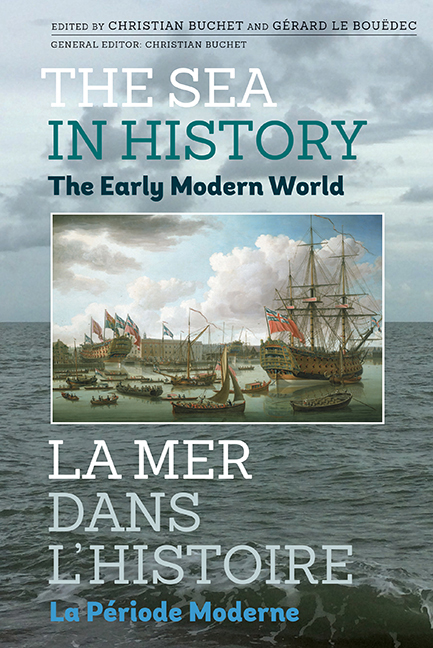Book contents
- Frontmatter
- Contents
- List of Illustrations
- List of Contributors
- Introduction générale et remerciements par
- General introduction and acknowledgements
- Introduction (français)
- Introduction (English)
- LA RÉUSSITE PAR LA MER:La reussite par la mer des territoires et des communautés littorales
- La construction d'un espace mondial: La circulation maritime et les ports
- Les dynamiques des circulations maritimes au XVIIIe siècle entre paix et guerre: ports, circuits, flottes entre logiques étatiques et logiques marchandes
- The European seaport system at the beginning of the early modern age
- Port location and development in the British Atlantic World in the seventeenth and eighteenth centuries
- Mutations et recompositions des flottes marchandes en Méditerranée
- Indian ports and European powers
- African Atlantic ports and trade fleets
- Les ports du Maghreb à l'époque moderne
- La forte croissance de l'économie des pêches et des échanges
- Les acteurs de la dynamique maritime
- LA PUISSANCE MARITIME INSTRUMENT DE LA PUISSANCE POLITIQUE ET D'UNE STRATÉGIE GLOBALE DE RAYONNEMENT VOIRE DE DOMINATION: Les puissances maritimes occidentales
- L'océan Indien, entre convoitises et indifférences
- Les puissances maritimes asiatiques
- L'Afrique
- La politique maritime et l'idéologie
- Mer et développement technologique
- Développement maritime et maîtrise économique et financière
- Développement maritime et maîtrise organisationnelle
- Conclusion (français)
- Conclusion (English)
- Conclusion générale par
- General conclusion by
- Miscellaneous Endmatter
- Miscellaneous Endmatter
Port location and development in the British Atlantic World in the seventeenth and eighteenth centuries
from La construction d'un espace mondial: La circulation maritime et les ports
Published online by Cambridge University Press: 11 May 2017
- Frontmatter
- Contents
- List of Illustrations
- List of Contributors
- Introduction générale et remerciements par
- General introduction and acknowledgements
- Introduction (français)
- Introduction (English)
- LA RÉUSSITE PAR LA MER:La reussite par la mer des territoires et des communautés littorales
- La construction d'un espace mondial: La circulation maritime et les ports
- Les dynamiques des circulations maritimes au XVIIIe siècle entre paix et guerre: ports, circuits, flottes entre logiques étatiques et logiques marchandes
- The European seaport system at the beginning of the early modern age
- Port location and development in the British Atlantic World in the seventeenth and eighteenth centuries
- Mutations et recompositions des flottes marchandes en Méditerranée
- Indian ports and European powers
- African Atlantic ports and trade fleets
- Les ports du Maghreb à l'époque moderne
- La forte croissance de l'économie des pêches et des échanges
- Les acteurs de la dynamique maritime
- LA PUISSANCE MARITIME INSTRUMENT DE LA PUISSANCE POLITIQUE ET D'UNE STRATÉGIE GLOBALE DE RAYONNEMENT VOIRE DE DOMINATION: Les puissances maritimes occidentales
- L'océan Indien, entre convoitises et indifférences
- Les puissances maritimes asiatiques
- L'Afrique
- La politique maritime et l'idéologie
- Mer et développement technologique
- Développement maritime et maîtrise économique et financière
- Développement maritime et maîtrise organisationnelle
- Conclusion (français)
- Conclusion (English)
- Conclusion générale par
- General conclusion by
- Miscellaneous Endmatter
- Miscellaneous Endmatter
Summary
ABSTRACT. This article focuses on the positioning and development of English Atlantic ports in the 17th and 18th centuries by drawing up a changing cartography of the port network. The most important ports combined physical features, even of mediocre quality, such as quays and basins, with economic activity based on a large volume of production and exchange. But the value of a port was determined by the dynamism and organization of merchants and traders.
RÉSUMÉ. Cet article s'intéresse à la localisation et au développement des ports du monde atlantique anglais aux XVIIe et XVIIIe siècle en dressant une cartographie évolutive du réseau portuaire. En fait les ports les plus importants combinent des atouts naturels même médiocres, avec pour certains des équipements comme les quais et les bassins, avec une activité économique qui s'appuie sur un fort volume de production et d'échanges. Mais la valeur d'un port se juge aussi à la dynamique et à l'organisation des marchands et négociants.
During the seventeenth and eighteenth centuries a British Atlantic world took shape with the colonisation of North America and the West Indies. By 1775 the British Empire in the Americas covered 88,803 square miles and contained a population of 8.6 million. Each of the British American settlements was originally based around ports and harbours, which served as nodal points for a maritime economy. North American and West Indian ports were connected to British ports through shipping, trade, and the movement of people across the Atlantic. Underpinned by a mercantilist framework in the form of various Navigation Acts, through which goods were largely required to be traded within the British Empire, ports and their merchants in Britain and British America had a pivotal role in the expansion of seaborne commerce for both Britain and her colonies. Smaller ports provided shipping points for ships to enter, transfer cargoes and receive crew, payments and refreshment. Larger ports, with waterborne and overland connections linking up with productive hinterlands, served as powerhouses of an intricate web of trading connections across the Atlantic that connected productive areas for raw materials and agricultural resources with centres of consumer demand.
- Type
- Chapter
- Information
- The Sea in History - The Early Modern World , pp. 158 - 167Publisher: Boydell & BrewerPrint publication year: 2017
- 1
- Cited by



